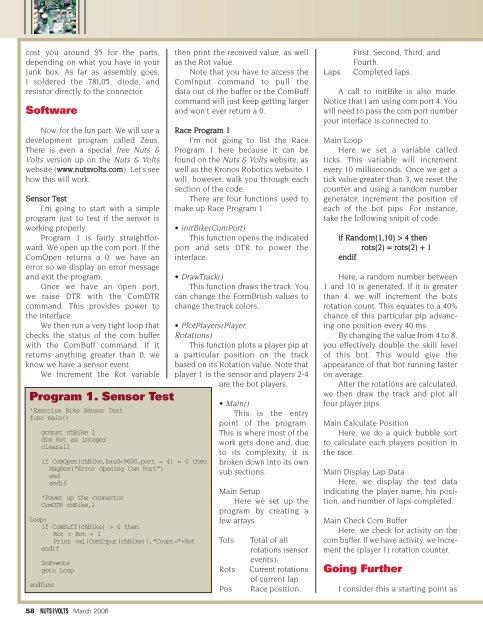Nuts & Volts
Nuts & Volts
Nuts & Volts
You also want an ePaper? Increase the reach of your titles
YUMPU automatically turns print PDFs into web optimized ePapers that Google loves.
cost you around $5 for the parts,<br />
depending on what you have in your<br />
junk box. As far as assembly goes,<br />
I soldered the 78L05, diode, and<br />
resistor directly to the connector.<br />
Software<br />
Now, for the fun part. We will use a<br />
development program called Zeus.<br />
There is even a special free <strong>Nuts</strong> &<br />
<strong>Volts</strong> version up on the <strong>Nuts</strong> & <strong>Volts</strong><br />
website (www.nutsvolts.com). Let’s see<br />
how this will work.<br />
Sensor Test<br />
I’m going to start with a simple<br />
program just to test if the sensor is<br />
working properly.<br />
Program 1 is fairly straightforward.<br />
We open up the com port. If the<br />
ComOpen returns a 0, we have an<br />
error so we display an error message<br />
and exit the program.<br />
Once we have an open port,<br />
we raise DTR with the ComDTR<br />
command. This provides power to<br />
the interface.<br />
We then run a very tight loop that<br />
checks the status of the com buffer<br />
with the ComBuff command. If it<br />
returns anything greater than 0, we<br />
know we have a sensor event.<br />
We increment the Rot variable<br />
Program 1. Sensor Test<br />
‘Exercise Bike Sensor Test<br />
func main()<br />
gconst chBike 1<br />
dim Rot as integer<br />
clearall<br />
if ComOpen(chBike,baud=9600,port = 4) = 0 then<br />
MsgBox(“Error Opening Com Port”)<br />
end<br />
endif<br />
‘Power up the connector<br />
ComDTR chBike,1<br />
Loop:<br />
if ComBuff(chBike) > 0 then<br />
Rot = Rot + 1<br />
Print val(ComInput(chBike)),”Count=”+Rot<br />
endif<br />
DoEvents<br />
goto Loop<br />
endfunc<br />
then print the received value, as well<br />
as the Rot value.<br />
Note that you have to access the<br />
ComInput command to pull the<br />
data out of the buffer or the ComBuff<br />
command will just keep getting larger<br />
and won’t ever return a 0.<br />
Race Program 1<br />
I’m not going to list the Race<br />
Program 1 here because it can be<br />
found on the <strong>Nuts</strong> & <strong>Volts</strong> website, as<br />
well as the Kronos Robotics website. I<br />
will, however, walk you through each<br />
section of the code.<br />
There are four functions used to<br />
make up Race Program 1.<br />
• initBike(ComPort)<br />
This function opens the indicated<br />
port and sets DTR to power the<br />
interface.<br />
• DrawTrack()<br />
This function draws the track. You<br />
can change the FormBrush values to<br />
change the track colors.<br />
• PlotPlayers(Player,<br />
Rotations)<br />
This function plots a player pip at<br />
a particular position on the track<br />
based on its Rotation value. Note that<br />
player 1 is the sensor and players 2-4<br />
are the bot players.<br />
• Main()<br />
This is the entry<br />
point of the program.<br />
This is where most of the<br />
work gets done and, due<br />
to its complexity, it is<br />
broken down into its own<br />
sub sections.<br />
Main Setup<br />
Here we set up the<br />
program by creating a<br />
few arrays.<br />
Tots<br />
Rots<br />
Pos<br />
Total of all<br />
rotations (sensor<br />
events).<br />
Current rotations<br />
of current lap.<br />
Race position.<br />
Laps<br />
First, Second, Third, and<br />
Fourth.<br />
Completed laps.<br />
A call to initBike is also made.<br />
Notice that I am using com port 4. You<br />
will need to pass the com port number<br />
your interface is connected to.<br />
Main Loop<br />
Here we set a variable called<br />
ticks. This variable will increment<br />
every 10 milliseconds. Once we get a<br />
tick value greater than 3, we reset the<br />
counter and using a random number<br />
generator, increment the position of<br />
each of the bot pips. For instance,<br />
take the following snipit of code:<br />
if Random(1,10) > 4 then<br />
rots(2) = rots(2) + 1<br />
endif<br />
Here, a random number between<br />
1 and 10 is generated. If it is greater<br />
than 4, we will increment the bots<br />
rotation count. This equates to a 40%<br />
chance of this particular pip advancing<br />
one position every 40 ms.<br />
By changing the value from 4 to 8,<br />
you effectively double the skill level<br />
of this bot. This would give the<br />
appearance of that bot running faster<br />
on average.<br />
After the rotations are calculated,<br />
we then draw the track and plot all<br />
four player pips.<br />
Main Calculate Position<br />
Here, we do a quick bubble sort<br />
to calculate each players position in<br />
the race.<br />
Main Display Lap Data<br />
Here, we display the text data<br />
indicating the player name, his position,<br />
and number of laps completed.<br />
Main Check Com Buffer<br />
Here, we check for activity on the<br />
com buffer. If we have activity, we increment<br />
the (player 1) rotation counter.<br />
Going Further<br />
I consider this a starting point as<br />
58 March 2006

















